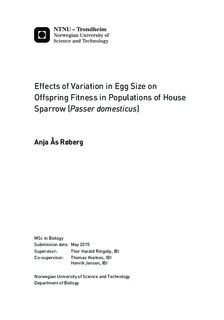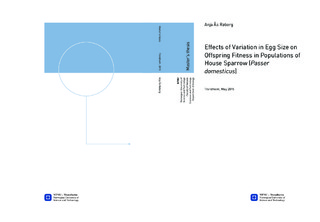| dc.description.abstract | 1. Egg size represents an important life-history trait, which may have effects on the fitness of offspring. The effect of variation in egg size on offspring fitness has been studied within many taxa, but there is still a lack of knowledge about both the adaptive significance of variation in egg size under fluctuating environmental conditions and the long-term effects of egg size on offspring fitness in wild species.
2. By studying an island population of house sparrow in northern Norway, I investigated the effects of among-brood variation in mean egg size, within-brood variation in egg size and climatic conditions on offspring fitness. Offspring fitness was measured as mortality from hatching until fledging stage and until recruitment stage, and as fledgling body mass and tarsus length.
3. The study revealed that large mean egg sizes reduced nestling mortality and had marginally positive effect on fledgling body mass, whereas large within-brood variation in egg size increased nestling mortality. There was also carry-over effects of mean egg size to the recruitment stage. Fledgling tarsus was little influenced by egg size. However, the fitness consequences of a given egg size was dependent on the weather conditions that the brood was exposed to during the early nestling stage. The difference in performance between individuals from small and large eggs was most pronounced under harsh climatic conditions. Overall, large egg sizes had a positive effect on offspring performance, but the results also indicated that offspring from large eggs suffered a higher probability of mortality until recruitment stage if they experienced high temperatures during the nestling stage.
4. The findings in this correlational study may suggest that the observed variation in egg size among and within broods may be adaptations towards temporal fluctuations in environmental conditions, and that the optimal egg size for maximizing offspring fitness may differ in relation to environmental conditions. | |

